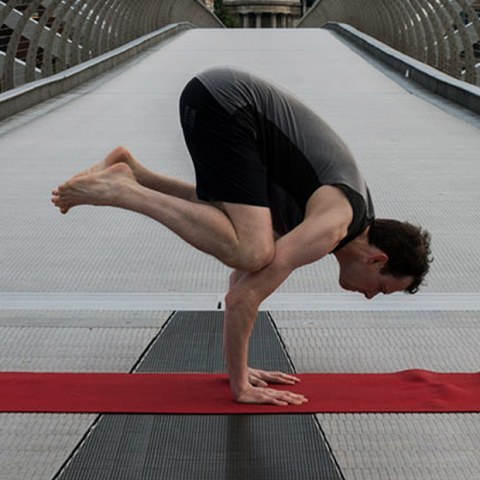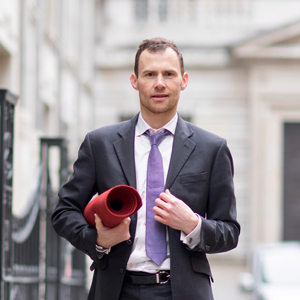The following has been transcribed from a Skype interview and edited for clarity.
Josh: Let’s start at the beginning, how did your yoga journey start? What personally drew you in?
Scott: Thinking about my wellbeing and wellness journey as a whole, yoga actually came into the story relatively late. It all started with an exposure to reiki in 2006, which is a type of energy healing practice. I had such a sublime, surreal experience – it felt like ‘suspended animation’ as if I was floating in mid-air. From there, I wanted to explore the more holistic side of healing further. Through a particular practitioner, I was seeing at the time, he introduced me to meditation – the more spiritual aspects of it and its origins. I thought to myself, “yes, I work in financial services but I’ve also been exposed to this very different way of living and thinking. This is really interesting.”
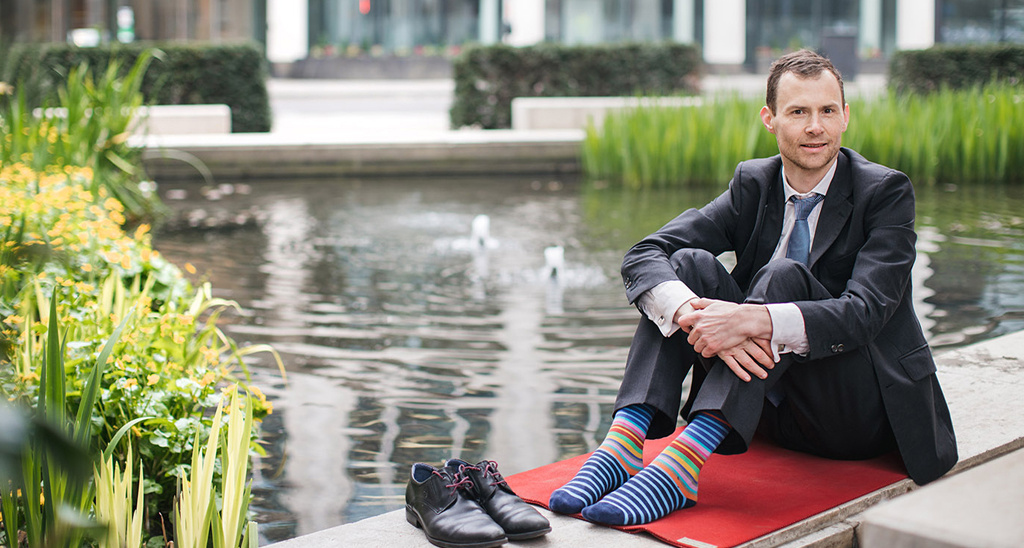
Photo credit: @yogaandphoto
Yoga came along just as I started my current job, about seven, coming up to eight years ago. My partner at the time suggested that I start doing yoga because it’s good for stress. Thinking about it, I guess I’m slightly unusual because probably for most guys they might do yoga to become stronger or more flexible rather than to primarily tackle stress.
For me, yoga was all about creating a good ‘space’ during stressful times. This was especially useful when I started my current role in 2012.
I was in the City, a new institution, I was managing a team for the first time, and yoga was really there to help me get through that period. It was almost like my refuge or sanctuary which I could go to regularly – just to create a little bit of space to take the edge off the day. As a result, I’d sleep better and go back to work the next day and be in a better space mentally.
Josh: You can see areas where your journey is perhaps different from the ‘usual’ yogi. Many people come to it for the physical aspects first and foremost or perhaps use it to supplement other forms of training, but you choose stress reduction as your entry point.
Scott: Yeah, I think so, it’s quite different. The entry point to yoga for many people is the ‘physical side’. They may have back pain, they may want to improve their flexibility, they will generally focus on the body. In contrast, if you look at classical yoga, there’s a famous bit in Patanajli’s Yoga Sutras that talks about yoga being all about reducing ‘fluctuations in the mind’. Modern yoga, as we know it today, has evolved and has become more synonymous with physical postures, as least as know it in the West.
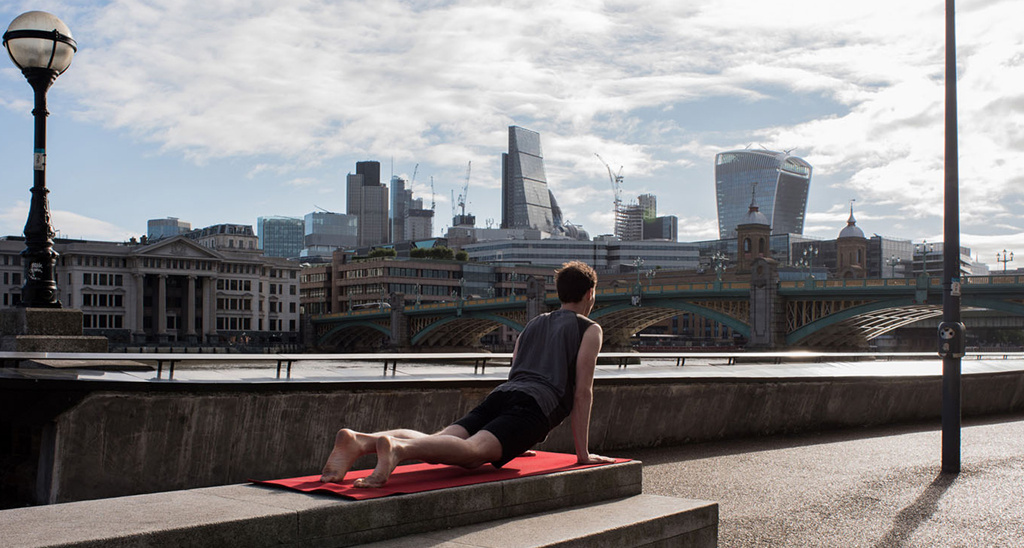
Photo credit: @yogaphotographer
Yoga though at its heart is really all about the ‘mind’. When you realise that yoga is actually an extremely useful tool for coping with and dealing with stress, then I think you have the potential to start transforming peoples’ lives. That’s been my experience of the students in my classes to date. People come into the class and they leave in a very different headspace – that’s the most rewarding aspect. You start being able to change people’s lives for the better, through the mental side of yoga, alongside their bodies becoming physically stronger and more flexible at the same time too.
Josh: Do you think modern, Western yoga perhaps need to get back those basic ideas? Or focus more on them. There are many schools of yoga, many brands, but are we as a collective focusing too much on the physical side?
Scott: It’s a really great question and as much as I would love to say I want people to dive really deep into the philosophy of yoga, it’s a very rich subject, quite detailed and to some extent difficult to process at times. Yoga philosophy is grounded in values and beliefs – how you apply those values to yourself and others. It’s very rare for someone in the West to become exposed to the more spiritual aspects without coming across the physical side of the practice first.
I think the physical side can act as a really good gateway to the practice of yoga. If you’re engaged with the physical side then it could strike up a sense of curiosity with the other facets of yoga. It might encourage people to go on retreats and that could create the opportunity for teachers to inspire students to take the practice further. I think there needs to be an appropriate entry point to the wider aspects of yoga and the physical practice is the perfect gateway to the wider subject.

Photo credit: @yogaandphoto
That said, we need to accept that yoga itself has also evolved from its traditional roots. What we think of as yoga today is not what yoga was 5,000 years ago. It’s personal. For some it’s about building strength and flexibility, for some it’s all about the therapeutic side of the practice through therapy. We’ve also got to remember that the body’s ability to heal is improved through movement, so yoga can be used to stimulate a healing response in the body.
To this extent, if someone simply wants to reduce their back pain through the physical side of yoga, without getting into the more spiritual side then that’s totally fine too. Yoga has many different applications now than when it was originally developed, which was originally a tool for ‘self-realisation’.
Josh: One of the many things that sets you apart is the application of your yoga training. Can you tell us a bit more about why you decided to focus on corporate wellness?
Scott: If you live and breathe within these financial organisations, then that becomes all you know. That side never really leaves you, it’s your DNA to some extent. I guess when I added on the yoga, it was natural for me to go co-workers and tell them “this is working for me, it’s helping me do my job better, why not come and try it? It could change your life.”
I know that there are thousands of others around the world offering retreats, training and so forth, they’re all doing great work, but that market is highly competitive and if everyone else is doing it, why would I want to as well?
I did actually take my students on retreat last year to Mallorca, which was a fabulous experience. I think though on the corporate wellness side, it’s all about inspiring others who you work with who would have not otherwise set foot in a yoga studio, in particular men.
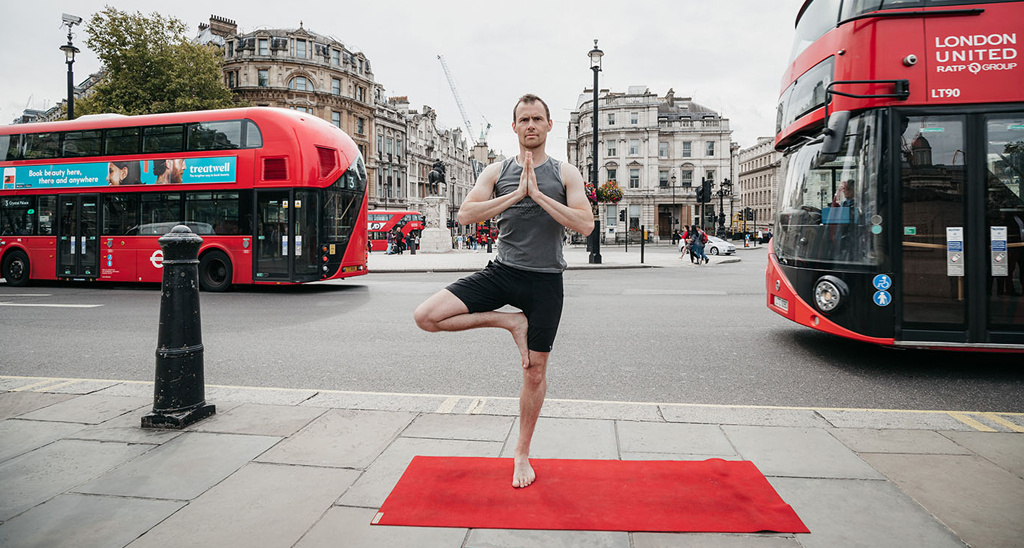
Photo credit: @yogaandphoto
The interesting thing with what I’ve started is that people who have never tried or would have been inclined to try yoga have got involved. You go to some yoga studios and it can be a little bit of a confronting environment. It might be a shoes-off policy, maybe there’s cucumber water, lots of pretty bodies around, incense, statues of Buddha and symbols from Hindu philosophy, and for the average person who’s a beginner, is this the type of environment that they feel welcome? It can be intimidating.
If you can provide that same service in a welcoming, neutral environment then you’re going to see a greater level of participation. I’ve just started a program here at the financial institution where I work including a ‘Yoga for Beginners’ course and I’ve had a lot of interest.
In all, I think it’s all about providing that service to others who would have not otherwise taken the first step to try yoga or learn about mindfulness and meditation, in an environment that is suitable and accessible.
Josh: Staying on corporate wellness, where should companies start if they want to truly help their employees?
Scott: Another really good question. It needs to start on a few levels. First, a company first needs to find out what their employees actually want. As much as I preach about yoga and meditation, I can tell you that there are people I work with who just aren’t interested in that, it’s just not for them. You can lead a horse to water but if they don’t want to drink, what can you do? For some it’s just not their thing, I get that.
My advice would be to ask what people really want. Maybe they want nutritional advice, information about how to sleep better, to know about other physical practices?
Secondly, you need a top-down approach, particularly with senior management. Role modelling is key. Ideally, this would involve management embracing and sponsoring corporate wellness schemes. If that happens, you’re going to improve the level of participation.
Josh: I imagine you’ve come across quite a few sceptics in your time. What’s your approach to people who are initially dismissive of the benefits of yoga, meditation and broader holistic practice?
Scott: It’s a difficult one, especially if someone is so opinionated about yoga, meditation etc… for example, plenty of people are too quick to form opinions that yoga is for ‘girls’ and other stereotypes and it’s not for them. Others may have formed an opinion about yoga based on what they see in social media. The key is to give them every opportunity to consider yoga and meditation in an accessible and non-judging way.
I would encourage people to at least give it a try. For a beginner, there’s always going to be a degree of apprehension and nerves about trying yoga. It’s all about making them feel safe and welcome and congratulating them for making that first step. Maybe those looking to set up a corporate wellness scheme could offer people a free or discounted class?
What I’ve been clear to say is that if you like it, great, if you don’t, that’s fine too. Invite curiosity. It may well be the start of a life-long love with yoga, that they never knew existed until you offered it to them.

Photo credit: @yogaandphoto
It all goes back to the idea of cultivating an environment where everybody feels welcome. We have to at least break down the stigma, the stereotype that yoga is for women, for hippies, for only flexible people etc. I hear it all the time, guys saying that they’re ‘not flexible’ enough to do yoga. The irony being you have to start somewhere if you want to ‘become’ flexible. One of my teachers has said that ‘stiffness is a gift’ as you’re less likely to hurt yourself. It’s actually the hypermobile, more experienced practitioners who are at greater risk of injury in my view.
Josh: I do think you’ve created that welcoming environment with Yogibanker, even thinking about the name… in many people’s minds, yoga and the world of finance are diametrically opposed to one another. You’ve shown yourself to be a role model and I think that’s why you’ve been as successful as you have been.
Scott: Thank you for your kind words. I think role-modelling has been key. It’s worked for me because I can relate to the people I’m teaching. If you’re bringing someone into an office who has had little experience of working in a corporate environment and they’re leading a class, perhaps the level of connection may not be present.
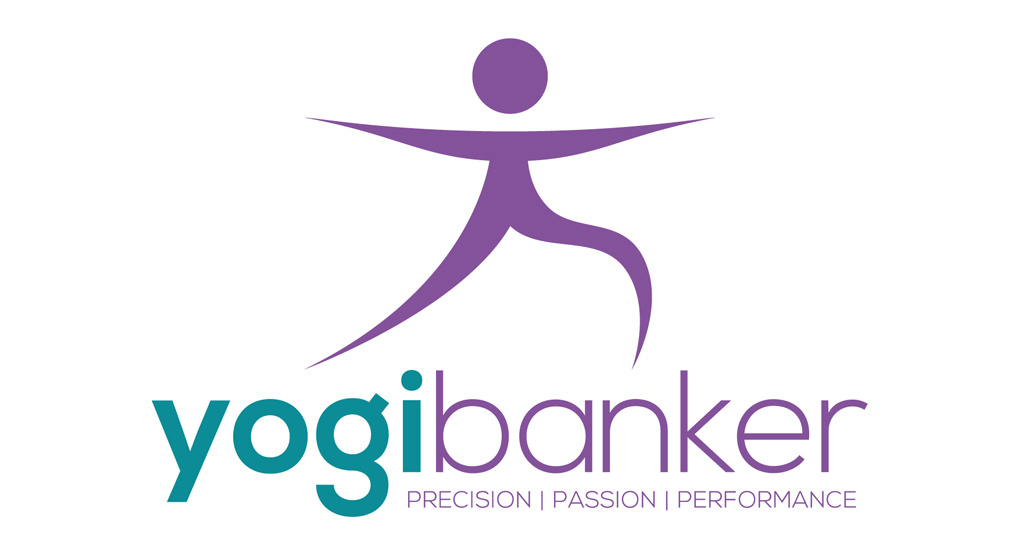
The teacher can lead a safe and suitable class but at the end of the day, yoga is about the relationship between teacher and student. Yoga is so rich and so deep; you need a teacher that’s going to inspire the student to keep practising. Someone who can relate to the student’s daily struggles, someone who knows what it’s like to work in those high-pressure roles, to sit in a chair all day, hunched over a computer.
Yes, someone who hasn’t had that experience could in their mind imagine what it’s like, but is that the same as someone who’s actually working in the same office? Someone that can say “guys, here’s what we need to do to reduce our back pain, open up through our shoulders, reduce neck tension and pain after working all day at our desks”. Talking about ‘we’ and ‘our’, rather than ‘you’ and ‘they’ can go a long way in my view.
Josh: Thinking long term, and perhaps broader, what kind of societal and cultural impact do you think Yogibanker can make?
Scott: Where do I want to take this? I don’t have any immediate plans to leave the finance industry and become a full-time yoga teacher. At this point in time, my mission is all about being on the inside and transforming the lives of those I work with and changing the reputation of the industry.
For me, there’s always going to be an interest in the financial sector but I also have a strong interest in yoga and meditation, so it’s all about merging the two. People ask me what Yogibanker is all about… I would say that to do your job well, you need some downtime too. You can’t exist in a state of high stress all the time. You need balance, you need time to ‘down-regulate’. Without it, we may become ill through stress, inflammation and ultimately a state of ‘dis-ease’. We need to think about ways to cope better and thrive in the financial sector and that’s where Yogibanker comes in.
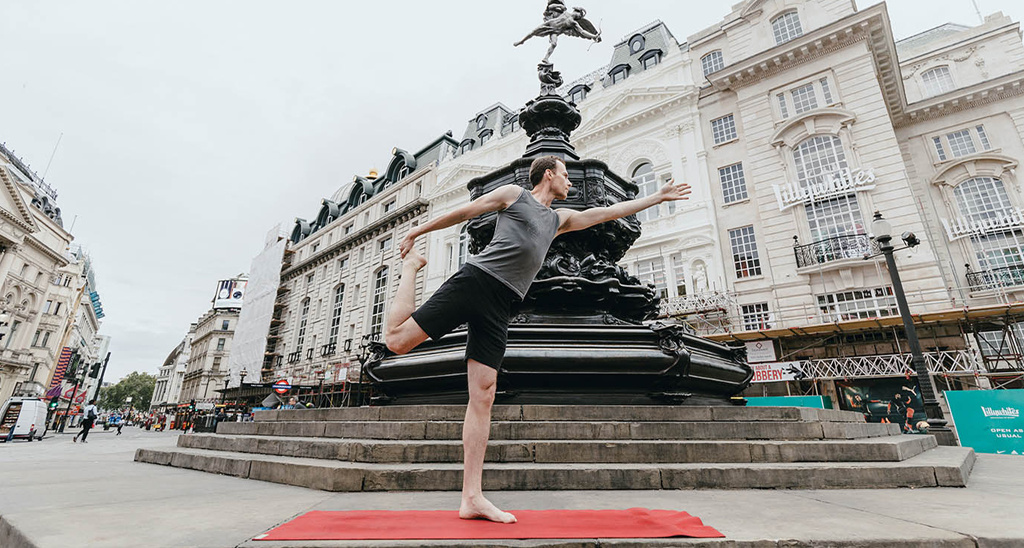
Photo credit: @yogaandphoto
I’m also interested in the idea of sustainable finance. The world is suffering from an ecological and climate crisis. My home country, Australia, recently experienced unprecedented levels of bush fire activity, and that’s been very distressing to watch.
How can the financial industry respond to the environmental issues the world currently faces and promote and invest in products that are sustainable and socially suitable for today’s world? How can it adapt to the shift from carbon-intensive to low carbon industries? The financial sector can be a leader in this, driving the allocation of resources to greener investments. These are the things that the financial sector is grappling with at the moment and it’s been quite interesting to be involved in this.
Josh: For those see you and what you’ve achieved as inspirational, where should they start if they want to improve corporate wellness in their own companies?
Scott: What I would say is to start at the beginning, at the ground roots level within your team. Be mindful of the institution’s policies and procedures when it comes to offering services to employees, and go from there.
For me, I started yoga within my immediate team at a space outside the bank, then people started coming from other teams and joining in. Same with the mindfulness and it’s just grown. I have a regular session every Monday lunchtime under the name of ‘Mindfulness Mondays’. In addition to the regular group in London, I have people dialling in from other offices including Birmingham and Frankfurt. It’s been very satisfying to share this wonderful practice with others throughout the institution.
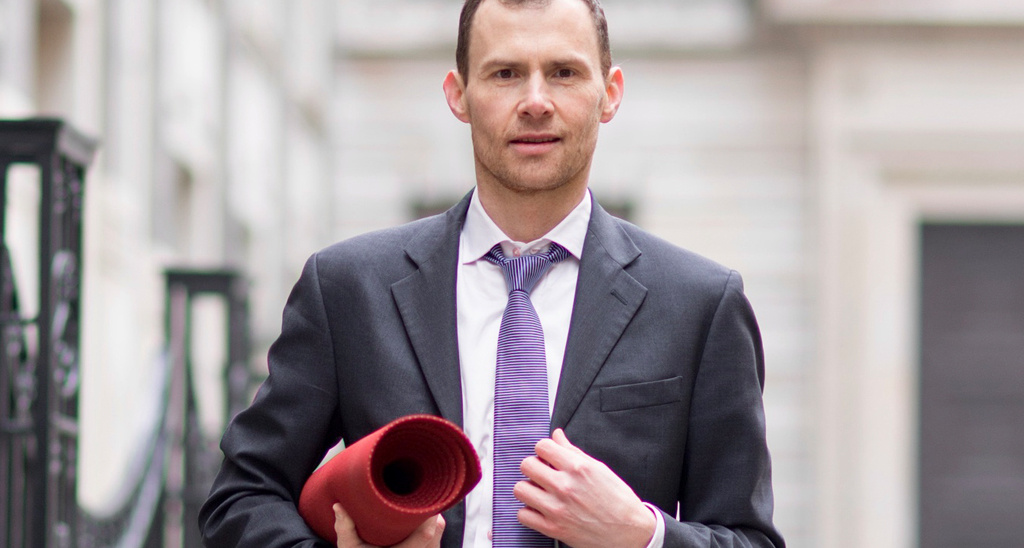
Photo credit: @yogaandphoto
At the end of the day, it’s all about organic growth. If you want to be a pioneer, you have to create something from nothing essentially. If there’s nothing like that in your organisation, you have to be able to demonstrate what’s possible – show to management what you’re doing already. Start at a local level, get people practising and watch the ripple effect throughout the organisation. You’ll see a groundswell of change.
My advice would be to get a group going and grow it. When things start spreading, people want to be a part of a movement. We all operate in tribes in a way. Once things are off the ground in a small-scale way perhaps you can then set out a plan to create a fully-fledged corporate wellness programme.
For example, in my current organisation, the idea of an employee-led yoga program two years ago seemed unfathomable. Now we have support from senior management, from HR, and myself and other colleagues who are yoga teachers and are making this happen. This has come from us showing what’s possible, letting those ideas germinate and demonstrating a commitment to the bank’s overall wellbeing strategy. The more you continue to develop ideas, the more it will grow.
Josh: For many people working in offices and jobs in general, work/life balance is such a hard thing to achieve. To your credit, you’ve created that flow where work and exercise can be incorporated and I think that’s a really powerful thing.
Scott: Thank you. It’s like if you wish to go to a yoga class, you have to get to and from a studio, you need to eat, where are you going to find the time to fit it all in? Especially if you’re in a high-pressure job working long hours. But if you can find a suitable place and time within the workplace as well as providing a place where people can come to practice yoga, meditate and experience mindfulness, it becomes less about work/life balance and more about work/life integration.
Josh: I imagine a lot of people do strive for that integration but don’t know how to achieve it.
Scott: The phrase ‘work/life balance’ has been around for a while, but the meaning has shifted since we’re in the age of 24/7 email culture and so forth. But if you can manage your life around your work so it’s seamless and flowing, then the whole picture starts to fit together. It’s something I’ve done and I hope to continue to help others achieve the same thing.
If you’d like to learn about Scott or his work at Yogibanker, click here to follow him on Twitter or visit his site.
